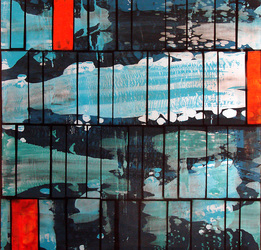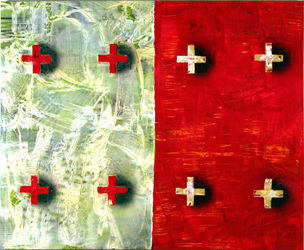Gerald Cournoyer Oglala Lakota
www.geraldcournoyer.com
Painting is a way of reflecting on my culture: past, present and future. My early paintings recreated Edward Curtis photographs from the early 1900s using large brush strokes, mixed colors and bold movements. These works honored my ancestors by rendering their images on canvas. By utilizing bold colors, movement and thick brush strokes across the canvas surface, I expanded the photographic imagery to more natural and spiritual images.
Since then, my paintings have evolved into a more abstract style, incorporating the use of geometric bead work and quill work forms. Historically, these designs were used as artistic forms to tell stories about dreams, visions and other unexplainable events. As I paint, I remember this ideology and continue to tell the stories of many lives through shapes, size, structure, scale, composition and colors in my paintings. The large non-figurative expanses of color and form offer the viewer an opportunity to explore the depth of stimulating color. The use of color in my paintings is similar to the traditional spirituality of family history.
In accordance with Lakota cosmology, the repetition of song and prayer brings our people closer to the supernatural beings which guide us throughout our lives. In my paintings, I transmit the importance of repetition in my compositions to induce a trance-like state in the viewer, bringing the soul closer to this particular enlightenment. In addition to non-figurative elements, I have also added many sizes of birds such as ravens and crows. The symbolism of the raven particularly important and is believed to bring story of the future to individuals and serves as a warning to animals that prey is near.
My current works incorporate a technique that I have rediscovered that was developed by an artist over thirty years ago. This “glass process” allows the paintings to look textured yet results in a reflective and shiny surface. This process allows me to create depth and three-dimensional imagery through the painting of abstract shapes and bold colors. As an artist, I strive to bridge the gap between traditional Lakota art and contemporary movements by combining symbols of old in a contemporary fashion.
Painting is a way of reflecting on my culture: past, present and future. My early paintings recreated Edward Curtis photographs from the early 1900s using large brush strokes, mixed colors and bold movements. These works honored my ancestors by rendering their images on canvas. By utilizing bold colors, movement and thick brush strokes across the canvas surface, I expanded the photographic imagery to more natural and spiritual images.
Since then, my paintings have evolved into a more abstract style, incorporating the use of geometric bead work and quill work forms. Historically, these designs were used as artistic forms to tell stories about dreams, visions and other unexplainable events. As I paint, I remember this ideology and continue to tell the stories of many lives through shapes, size, structure, scale, composition and colors in my paintings. The large non-figurative expanses of color and form offer the viewer an opportunity to explore the depth of stimulating color. The use of color in my paintings is similar to the traditional spirituality of family history.
In accordance with Lakota cosmology, the repetition of song and prayer brings our people closer to the supernatural beings which guide us throughout our lives. In my paintings, I transmit the importance of repetition in my compositions to induce a trance-like state in the viewer, bringing the soul closer to this particular enlightenment. In addition to non-figurative elements, I have also added many sizes of birds such as ravens and crows. The symbolism of the raven particularly important and is believed to bring story of the future to individuals and serves as a warning to animals that prey is near.
My current works incorporate a technique that I have rediscovered that was developed by an artist over thirty years ago. This “glass process” allows the paintings to look textured yet results in a reflective and shiny surface. This process allows me to create depth and three-dimensional imagery through the painting of abstract shapes and bold colors. As an artist, I strive to bridge the gap between traditional Lakota art and contemporary movements by combining symbols of old in a contemporary fashion.






